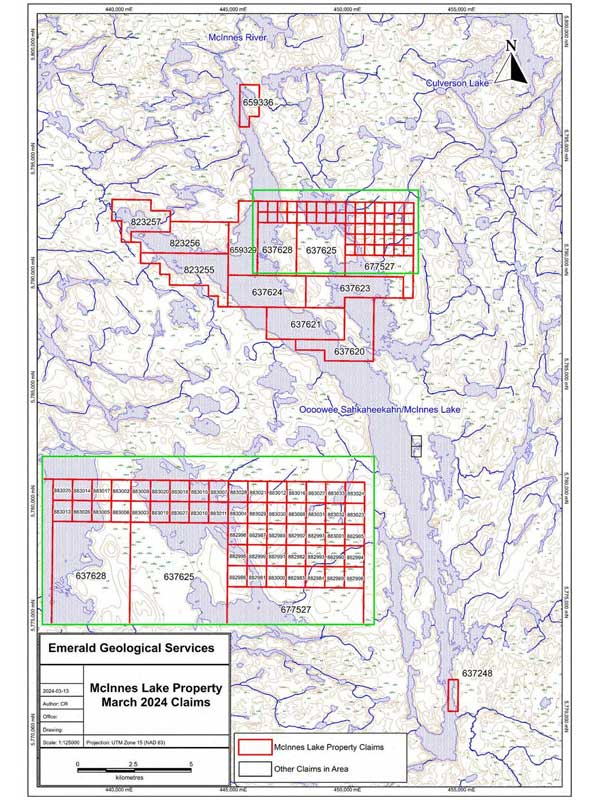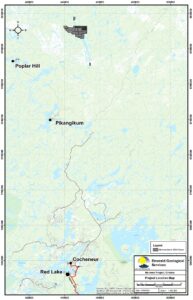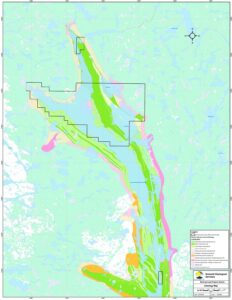McInnes Lake Project Summary

EGS currently owns the Gold-Lithium-Base Metal McInnes Lake Property in the Red Lake region in Northwestern Ontario. The property consists of 66 claims and is located approximately 120 km north of the town of Red Lake, Ontario, accessible by float plane from Red Lake.
Results of up to 1126 ppm Li had been obtained from boulders during the 2021 programs, prompting follow-up to locate bedrock sources of these anomalies. Gold values up to 3.56 gpt had been obtained from the 2021 programs as well, corresponding to previously unidentified showings. No gold or lithium showings were known in the McInnes Lake Greenstone Belt (MLGB) prior to the 2021 programs; however, the OGS had identified a fertile granite-pegmatite system in the early 2000s in the northern part of the greenstone belt.
The 2023 field program was successful in most of its objectives. A possible source area for the Discovery Boulder (1126 ppm Li) from 2021 was identified in the exocontact pegmatite field east of the McInnes North Pluton (MNP), with host rocks returning up to 984 ppm Li, 649 ppm Rb, and 216 ppm Cs adjacent to Pegmatite 2. The Discovery Boulder itself was re-sampled and returned up to 1200 ppm Li. Outcrop very similar in appearance to the boulder was located northwest of Pegmatite 3, returning up to 788 ppm Li, 167 ppm Rb and 64 ppm Cs. Anomalous rare element mineralization was identified within the exocontact pegmatites themselves, with bulk samples returning up to 354 ppm Li (Peg 3), 1290 ppm Rb (Peg 1), and 216 ppm Cs (Peg3), while samples of blocky k-feldspar returned up to 2750 ppm Rb and 413 ppm Cs (Peg 2). Glacial striae at 070 degrees were noted at Pegmatite 1, which lines up with the location of the Discovery Boulder.
The McInnes NE Arm Pegmatite, located about 1.5 km north-northeast of the MNP, contains elevated rare element concentrations, with bulk samples returning up to 134 ppm Li, 906 ppm Rb, 145 ppm Cs, 36.6 ppm Ta (highest of the program), 554 ppm B, and 73 ppm Nb, and blocky k-feldspar returning up to 1120 ppm Rb. This could represent a separate exocontact pegmatite swarm. The presence of tourmaline here is rare in the MNP system so far observed.
Anomalous gold was discovered in two new locations: the west side of Power Bay (557 ppb Au, 2700 ppm As) from quartz veining in metasediments; and the west shore of northern McInnes Lake (1.4 gpt Au, 2150 ppm Bi) from quartz veining in an east-northeast-trending shear in mafic metavolcanics. Both areas are worthy of follow-up prospecting. The showing west of Power Bay is located 3.7 km along strike to the northwest of the highest value from 2021 (3.56 gpt Au with 3185 ppm As), and the area in between has seen very little exploration. It appears that arsenic could be a pathfinder in this system, while bismuth, another common accessory element in orogenic gold systems, could be a pathfinder on the west side of McInnes Lake.


